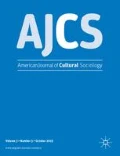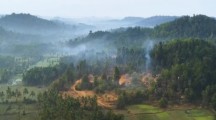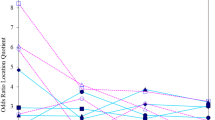Abstract
Current research on artistic groups suggests the career benefits of being place-based. This article examines the Chicago Imagists—a group defined by local recognition in Chicago and limited national renown—to explain the limits of these benefits when actors’ interests within a local scene diverge. Studying critical discourse on the Imagists from the 1960s to 1980s, we explain how “critical circles,” tied to the interests of regional evaluators, mediate artistic reputations. During initial group formation, Chicago artists and critics shared the goal of developing a distinct local art. However, critics’ investment in defining the boundaries of a “Chicago” style to further their careers ultimately diverged from Imagists’ investment in mastering a broader “American” style to further theirs. Chicago critics’ ensuing debates about the parochial limits of the label—and New York critics’ framing of Imagist work as provincial—further came to organize the very regionalism Imagist artists hoped to evade. We argue that attending to the divergent interests in the cultural field within which collaborative circles operate expands understanding of how affordances of place shape artistic careers. This study has further implications for theorizing the interplay of impression management and strong program perspectives on cultural wealth.
Similar content being viewed by others
Notes
Here we acknowledge co-presence can mean many things. It often involves being in the same physical location. However, it may, in some instances, allow for creatives being in other locations (as in the case of transnational or even online circles), so long as ongoing communication is both possible and maintained.
In art history, discussions of regionalism typically refer to a particular movement—American Regionalism—consisting of naturalist paintings celebrating local and national American culture in the early-to-mid twentieth century (Balken 2009). This movement—lauded throughout the 1930s—fell into disfavor by critics who deemed it provincial, anti-modernist, and perniciously nationalist, particularly in contrast to the Abstract Expressionist movement that emerged in New York in the 1940s (Dennis 1998).
For an impressive archive of Imagist work, see https://chicagoimagists.com.
According to Paschke, he and Flood approached Baum as a “pre-packaged” group. Ramberg, speaking about the 1968 HPAC “False Image” show, stated that those featured (among them, Brown, Hanson, and herself) had a different experience; according to Yoshida, they were “sort of discovered in school,” when Nutt brought Baum to SAIC to see their work (Ackland Art Museum 1981, p. 21).
Warren (2011, p. 19) relays that various titles were proposed during different early gatherings of these artists, in which Wirsum did not understand the repeated references by the others to “Harry” (Harry Bouras, an artist of the preceding “Monster Roster” generation of Chicago artists). This led him to ask: “Harry who?” Given the group’s “penchant for puns and wordplay,” his question evolved into “Hairy Who.”.
Ten of the 14 Imagist artists we identify in our methods section participated. The show brought international exposure to work previously exhibited at HPAC and, concurrently, at the San Francisco Art Institute in 1968, the Corcoran Gallery in Washington, D.C in 1969, and the School of Visual Arts Gallery in New York, also in 1969.
Roger Brown Study Collection Archive, the School of the Art Institute of Chicago. Undated document by Roger Brown regarding art schools and the presupposition of such a thing as natural.
Roger Brown Study Collection Archive, the School of the Art Institute of Chicago. Letter from Roger Brown to Neal Benezra regarding Benezra’s essay on the work of Ed Paschke.
In each cultural domain, distinct fields of evaluation exist, due to particular historical contingencies (see Kostelanetz, 1974 on the role of critics in creating literary status). Here it bears note that while New York may be dominant in some arenas, it is not necessary dominant in all, as we address in our conclusion.
References
Adrian, D. 1996. Private Treasures, Public Spirit. In Art in Chicago 1945–1995, ed. L. Warren, 69–83. Chicago: Museum of Contemporary Art.
Ackland Art Museum. 1981. A Conversation. Some Recent Art from Chicago, 20–37. Ackland Art Museum: Chapel Hill.
Alexander, J. 2003. The Meanings of Social Life: A Cultural Sociology. New York: Oxford University Press.
Alexander, J.C., and P. Smith. 2003. The Strong Program in Cultural Sociology: Elements of a Structural Hermeneutics. In The Meaning of Social Life: A Cultural Sociology, ed. J.C. Alexander, 11–26. New York: Oxford University Press.
Antal, A.B., M. Hutter, and D. Stark (eds.). 2015. Moments of Valuation: Exploring Sites of Dissonance. Oxford: Oxford University Press.
Artner, A. G. 1977. Provincialism Keeps Muzzle on the Muse. Chicago Tribune, Jan 2, E4.
Artner, A. G. 1987. Troubling Images: Evaluating the Chicago School, 20 Years Later. Chicago Tribune, Nov 1, K8.
Artner, A. G. 2006. Early Attacks on Imagism Lacked Reason. Chicago Tribune, Nov 26. https://www.chicagotribune.com/news/ct-xpm-2006-11-26-0611250232-story.html. Accessed 28 Mar 2020.
Babon, K. 2006. Composition, Coherence, and Attachment: The Critical Role of Context in Reception. Poetics 34 (3): 151–179.
Balken, D. 2009. After Many Springs: Regionalism, Modernism, and the Midwest. New Haven, CT: Yale University Press.
Bandelj, N., and F. Wherry (eds.). 2011. The Cultural Wealth of Nations. Stanford, CA: Stanford University Press.
Baumann, S. 2007. A General Theory of artistic Legitimation: How Art Worlds are Like Social Movements. Poetics 35 (1): 47–65.
Beljean, S., P. Chong, and M. Lamont. 2015. A Post-Bourdieusian Sociology of Valuation and Evaluation for the Field of Cultural Production. In Routledge International Handbook of the Sociology of Art and Culture, ed. L. Hanquinet and M. Savage, 38–48. Oxford and New York: Routledge.
Borowiecki, K. 2013. Geographic Clustering and Productivity: An Instrumental Variable Approach for Classical Composers. Journal of Urban Economics 73 (1): 94–110.
Bourdieu, P. 1993. The Field of Cultural Production. New York: Columbia University Press.
Buchholz, L. 2018. Rethinking the Center-Periphery Model: Dimensions and Temporalities of Macro-structure in a Global Field of Cultural Production. Poetics 71: 18–32.
Canaday, J. (1972) No Need to Man the Barricades. The New York Times, July 23, D15.
Cheyne, A., and A. Binder. 2010. Cosmopolitan Preferences: The Constitutive Role of Place in American Elite Taste for Hip-Hop Music 1991–2005. Poetics 38 (3): 336–364.
Chicago Imagist Art: May 13 to June 25, 1972. 1972. Chicago: Museum of Contemporary Art.
Childress, C. 2015. Regionalism and the Publishing Class: Conflicted Isomorphism and Negotiated Identity in a Nested Field of American Publishing. Cultural Sociology 9 (3): 364–378.
Corse, S. 1995. Nations and Novels: Cultural Politics and Literary Use. Social Forces 73 (4): 1279–1308.
Corse, S. 1997. Nationalism and Literature: The Politics of Culture in Canada and the United States. Cambridge: Cambridge University Press.
Corte, U. 2013. A Refinement of Collaborative Circles Theory: Resource Mobilization and Innovation in an Emerging Sport. Social Psychology Quarterly 76 (1): 25–51.
Cozzolino, R. 2007. Chicago's Modernism. In Art in Chicago: Resisting Regionalism, Transforming Modernism, ed. R. Cozzolino, 9–24. Philadelphia: Pennsylvania Academy of the Fine Arts.
Dennis, J. 1998. Renegade Regionalists: The Modern Independence of Grant Wood, Thomas Hart Benton, and John Steuart Curry. Madison, WI: University of Wisconsin Press.
DiMaggio, P. 1987. Classification in Art. American Sociological Review 52 (4): 440–455.
Farrell, M. 2001. Collaborative Circles: Friendship Dynamics and Creative Work. Chicago: University of Chicago Press.
Fine, G.A. 2001. Difficult Reputations: Collective Memories of the Evil, Inept, and Controversial. Chicago: University of Chicago Press.
Fleischman, S. 2011. Fanning the Flames in the Windy City. In Art in Chicago 1945–1995, ed. L. Warren, 25–33. Chicago: Museum of Contemporary Art.
Florêncio, J. 2016. Abstract Expressionism: How New York Overtook Europe to Become the Epicenter of Western Art. The Conversation, Sept 23. https://theconversation.com/abstract-expressionism-how-new-york-overtook-europe-to-become-the-epicentre-of-western-art-65820. Accessed 28 Mar 2010.
Foster, H., R. Krauss, Y.A. Bois, and B.H.D. Buchloh. 2004. Art Since 1900: Modernism. Antimodernism, Postmodernism: Thames & Hudson.
Frueh, J. 1978. Chicago’s Emotional Realists. Artforum 17: 41–47.
Gieryn, T. 2000. A Space for Place in Sociology. Annual Review of Sociology 26: 463–496.
Goldberger, P. 1977. A Critic’s Guide to Chicago’s Loop, The Birthplace of the Skyscraper. The New York Times, Sept 25, 1, 18.
Grams, D. 2010. Producing Local Color: Art Networks in Ethnic Chicago. Chicago: University of Chicago Press.
Griswold, W. 2008. Regionalism and the Reading Class. Chicago: University of Chicago Press.
Griswold, W., and N. Wright. 2004. Cowbirds, Locals, and the Dynamic Endurance of Regionalism. American Journal of Sociology 109 (6): 1411–1451.
Griswold, W., and H. Wohl. 2015. Evangelists of Culture: One Book Programs and the Agents Who Define Literature, Shape Tastes, and Reproduce Regionalism. Poetics 60: 96–109.
Guilbaut, S. 1983. How New York Stole the Idea of Modern Art: Abstract Expressionism, Freedom and the Cold War. Chicago: University of Chicago Press.
Guthrie, D., and J.A. Allen. 1973. Chicago—Regionalism? Studio International 186: 182–186.
Hannerz, U. 2015. Center-Periphery Relationships. International Encyclopedia of the Social & Behavioral Sciences 3 (2): 308–311.
Holg, G. 1998. Art of the City: The Imagists - and Beyond. Chicago Sun-Times, Mar 22, 1, 14.
Jaffee, B. 1996. Pride of Place. In Art in Chicago 1945–1995, ed. L. Warren, 53–68. Chicago: Museum of Contemporary Art.
Janssen, S., G. Kuipers, and M. Verboord. 2008. Cultural Globalization and Arts Journalism: The International Orientation of Arts and Culture Coverage in Dutch, French, German, and US newspapers, 1955 to 2005. American Sociological Review 73 (5): 719–740.
Kidder, J. 2017. Civil and Uncivil Places: The Moral Geography of College Republicans. American Journal of Cultural Sociology 6 (1): 161–188.
Knipe, T. (ed.). 1980. Who Chicago?: An Exhibition of Contemporary Imagists. Sunderland: Ceolfrith Gallery at the Sunderland Arts Centre.
Koreman, R. 2014. Legitimating Local Music: Volksmuziek, Hip-Hop/Rap and Dance Music in Dutch Elite Newspapers. Cultural Sociology 8 (4): 501–519.
Kostelanetz, R. 1974. The End of Intelligent Writing: Literary Politics in America. New York: Sheed and Ward.
Kuspit, D. 1976. Regionalism Reconsidered. Art in America, July/August, 64–69.
Lamont, M. 2012. Toward a Comparative Sociology of Valuation and Evaluation. Annual Review of Sociology 38: 201–221.
Lamont, M., and M. Fournier (eds.). 1992. Cultivating Differences: Symbolic Boundaries and the Making of Inequality. Chicago: University of Chicago Press.
Lamont, M., and V. Molnár. 2002. The Study of Boundaries in the Social Sciences. Annual Review of Sociology 28: 167–195.
Lamont, M., S. Pendergrass, and M. Pachucki. 2015. Symbolic Boundaries. In International Encyclopedia of Social and Behavioral Sciences, ed. J. Wright, 850–855. Oxford: Elsevier.
Lang, G.E., and K. Lang. 1988. Recognition and Renown: The Survival of Artistic Reputation. American Journal of Sociology 94 (1): 79–109.
Lang, G.E., and K. Lang. 1990. Etched in Memory: The Building and Survival of Artistic Reputation. Chapel Hill, NC: University of North Carolina Press.
Lehman, D. 1995. The Artistic Triumph of New York. American Heritage 46(5). https://www.americanheritage.com/artistic-triumph-new-york. Accessed 29 Sept 2019.
Lena, J.C. 2012. Banding Together: How Communities Create Genre in Popular Music. Princeton, NJ: Princeton University Press.
Madison Museum of Contemporary Art (MMoCA). 2011. Chicago Imagists. Madison, WI: Madison Museum of Contemporary Art.
Malcolm, A. H. 1983. Chicago. The New York Times Magazine, Apr 10, 24–29, 69–72, 98
McLaughlin, N. 2008. Collaborative Circles and Their Discontents. Sociologica (2/2008). https://www.rivisteweb.it/doi/10.2383/27714. Accessed 17 Oct 2019.
Menand, L. 2017. Thirteen Crucial Years for Art in Downtown New York. The New Yorker, Mar 28. https://www.newyorker.com/culture/cultural-comment/thirteen-crucial-years-for-art-in-downtown-new-york. Accessed 29 Sept 2019.
Muniz, A., T. Norris, and G.A. Fine. 2014. Marketing Artistic Careers: Pablo Picasso as Brand Manager. European Journal of Marketing 48 (1/2): 68–88.
Oberlin, K., and T. Gieryn. 2015. Place and Culture-Making: Geographic Clumping. Poetics 50: 20–43.
Pannier, F. 2001 [1974]. A Painter Reviews Chicago, Part I. In The Essential New Art Examiner, 15–18. Dekalb, IL: Northern Illinois University Press.
Parker, J., and U. Corte. 2017. Placing Collaborative Circles in Strategic Action Fields: Explaining Differences between Highly Creative Groups. Sociological Theory 35 (4): 261–287.
Pentimenti Productions. 2014. Hairy Who and the Chicago Imagists. Documentary DVD.
Peterson, R. 1997. Creating Country Music: Fabricating Authenticity. Chicago: University of Chicago Press.
Phillips, L. 1999. The American Century: Art & Culture, 1950–2000. New York: Whitney Museum of American Art and W.W. Norton & Company.
Plattner, S. 1996. High Art Down Home: An Economic Ethnography of a Local Art Market. Chicago: University of Chicago Press.
Regnault, M. 2011. Converting (or Not) Cultural Wealth into Tourism Profits: Case Studies of Reunion Island and Mayotte. In The Cultural Wealth of Nations, ed. N. Bandelj and F. Wherry, 156–176. Stanford, CA: Stanford University Press.
Reinhard, S., D. Watkins, A. DeSantis, R. Taylor, and S. Mitter. 2019. Mapping the Whitney Biennial. The New York Times, July 5. https://www.nytimes.com/interactive/2019/07/05/arts/design/whitney-biennial-maps.html. Accessed 21 Aug 2019.
Russell, J. 1982. Gallery View; 'The Hairy Who’ and Other Messages from Chicago. The New York Times, Jan 31, 002029.
Schjeldahl, P. 1974. Whimsical Amalgam of Pop Art and Surrealism. The New York Times, Sept 15, 29.
Schjeldahl, P. 1976. Letter from Chicago. Art in America, July/August, 52–58.
Schjeldahl, P. 1985. ‘Chicagoization:’ Some Second Thoughts on the Second City. The New Art Examiner, May, 28–32.
Schjeldahl, P. 2018. Bruce Nauman’s Restive Humor. The New Yorker, Nov 5. https://www.newyorker.com/magazine/2018/11/05/bruce-naumans-restive-humor. Accessed 28 Mar 2020.
Schulze, F. 1963. The Image and the Dream: Identities of Postwar Chicago Art. Chicago Daily News, July 6, 36–40.
Schulze, F. 1971. Art News in Chicago. ARTnews 70 (7): 45–55.
Schulze, F. 1972a. Fantastic Images. Chicago: Follett.
Schulze, F. 1972b. Chicago Imagist Art. In: Chicago Imagist Art: May 13 to June 25, 1972. Chicago: Museum of Contemporary Art.
Schulze, F. 1996. Art in Chicago: The Two Traditions. In Art in Chicago 1945–1995, ed. L. Warren, 13–34. Chicago: Museum of Contemporary Art.
Selz, P. 1950s. Surrealism and the Chicago Imagists of the 1950s: A Comparison and Contrast. Art Journal 45 (4): 303–306.
Shils, E. 1972. The Intellectuals and the Powers. Chicago: University of Chicago Press.
Shils, E. 1975. Center and Periphery: Essays in Macrosociology. Chicago: University of Chicago Press.
Shrum, W. 1996. Fringe and Fortune: The Role of Critics in High and Popular Art. Princeton, NJ: Princeton University Press.
Smith, P. 1999. The Elementary Forms of Place and their Transformations: A Durkheimian Model. Qualitative Sociology 22 (1): 13–36.
Smith, R. 2004. Ed Paschke, Painter, 65, Dies; Pop Artist with Dark Vision. The New York Times, Dec 1, A00028.
Thornton, S. 2008. Seven Days in the Art World. New York: W.W. Norton & Company.
Thorson, A., and J. Yood. 2001[1985]. Who Follows the Hairy Who? In: The Essential New Art Examiner, pp. 147–154. Dekalb, IL: Northern Illinois University Press.
van Venrooij, A. 2009. The Aesthetic Discourse Space of Popular Music: 1985–86 and 2004–05. Poetics 37 (4): 315–332.
Vermurlen, B. 2016. Structural Overlap and the Management of Cultural Marginality: The Case of Calvinist Hip-Hop. American Journal of Cultural Sociology 4 (1): 68–106.
Vine, R. 1997. Where the Wild Things Were. Art in America, May, 98–111.
Warren, L. 2011. Chicago Imagism: The Derivation of a Term. Chicago Imagists, 15–23. Madison Museum of Contemporary Art: Madison.
Wolfe, T. 1975. The Painted Word. New York: Farrar, Straus, & Giroux.
Yood, J. 2001 [1985]. 1984–1987: Introduction. In The Essential New Art Examiner, 135–138. Dekalb, IL: Northern Illinois University Press.
Acknowledgements
The authors would like to thank Amanda Anthony, Larissa Buchholz, Clayton Childress, Frédéric Godart, Wendy Griswold, Jennifer C. Lena, Ann Mullen, Kathleen (Casey) Oberlin, and Hannah Wohl for their helpful feedback and comments at different stages of this manuscript. We are further grateful for the incisive editorial and reviewer guidance at AJCS, and for the artists, critics, and administrators who shared their Chicago stories with us. Support for this research was generously provided by a MacArthur Collaborative Summer Research Grant through the Northwestern University Sociology Department.
Author information
Authors and Affiliations
Corresponding author
Additional information
Publisher's Note
Springer Nature remains neutral with regard to jurisdictional claims in published maps and institutional affiliations.
Rights and permissions
About this article
Cite this article
Mangione, G., Fine, G.A. Critical circles and regional reputations: the Chicago imagists and the politics of art world peripheries. Am J Cult Sociol 9, 555–580 (2021). https://doi.org/10.1057/s41290-020-00101-2
Published:
Issue Date:
DOI: https://doi.org/10.1057/s41290-020-00101-2




